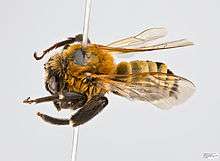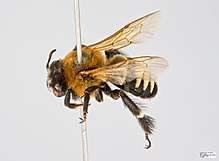Ptilothrix
| Ptilothrix | |
|---|---|
 | |
| P. relata male | |
| Scientific classification | |
| Kingdom: | Animalia |
| Clade: | Euarthropoda |
| Class: | Insecta |
| Order: | Hymenoptera |
| Family: | Apidae |
| Tribe: | Emphorini |
| Genus: | Ptilothrix Smith, 1853.[1] |
Ptilothrix is a genus within the tribe Emphorini[2] of the family Apidae (bumblebees, euglossines, honeybees, stingless bees).[3]Bees of this genus are large and can range from 7 to 15 millimeters[4]. Ptilothrix species are solitary ground nesting bees. The genus is known for having long leg hairs, called scopae, to help gather pollen to provision their nests. It is well documented that the Ptilothrix genus specializes on specific families of plants for their pollen, including the Malvaceae, Convolvulaceae, Onagraceae, Cactaceae, Pontederiaceae and Asteraceae families[5]. The genus is found in the new world, with species ranging from North to South America.
Bees of the Ptilothrix genus are solitary. Unlike honeybees or other eusocial bee species, solitary bees do not form a hive or have division of labor of individuals. Females build individual nests for their offspring, however some species will build their nests in aggregations of the same species in the same area.[2]
Species
The genus contains the following species:[3]
- Ptilothrix bombiformis (hibiscus bee, rose-mallow bee, eastern digger bee)
- Ptilothrix chacoensis
- Ptilothrix concolor
- Ptilothrix corrientium
- Ptilothrix fructifera
- Ptilothrix fuliginosa
- Ptilothrix heterochroa
- Ptilothrix lynchii
- Ptilothrix nemoralis
- Ptilothrix nigerrima
- Ptilothrix plumata
- Ptilothrix relata
- Ptilothrix scalaris
- Ptilothrix sumichrasti
- Ptilothrix tricolor
- Ptilothrix vulpihirta
Morphology
.jpg)
Bees of this genus are large and can range from 7 to 15 millimeters. They can be identified from other closely related genera in the Emphorini tribe by their lack of arolia and their scopa, or leg hairs. The scopae are located on the hind tibia, and are arranged in a unique branching pattern. Other distinguishing morphological characteristics include a hairy propodeal triangle, and a more slender body shape than other Emphorines.

The scopa of the Ptilothrix genus serves many unique functions. It gives the species the ability to walk on the surface of water while being supported by their legs. Their long leg hairs also aid in gathering pollen. The size of their leg hairs aids them in collecting larger grained pollen, such as those found in the Malvaceae family. This niche may allow Ptilothrix species to thrive alongside other introduced species, such as honeybees, as it may reduce interspecific competition for pollen resources. The use of scopae for pollen transport may have evolved later since other species that do not provision pollen also have scopae. Scopae are thought to have advantages in evapotranspiration and reflecting sunlight to keep bees cool in hot, arid environments. By contrast, other members in the Apidae, including honeybees and bumblebees have pollen baskets or corbiculae to carry their pollen on their legs or abdomen.
Range
Species of this genus are found throughout North and South America, from northcentral eastern U.S.A. to central Mexico, and from northern Brazil to northern Patagonia in Argentina. As with most bee species, they are most abundant at latitudes outside of the tropics [4]. The largest diversity of the genus occurs in temperate South America. Ptilothrix bombiformis is the only species in the eastern United States. Habitats can range from lowland areas near streams and along the coast, to higher elevations in South American mountain ranges.
Nesting behavior and construction
Ptilothrix are also called the chimney bees, referring to the small chimney or turret of the nest entrance that can be seen on the soil surface. While specific nesting behavior varies by species, all female members of this genus create ground nests in hardpacked soil. Once a site is chosen, the female transports water to her nesting site to soften the soil for excavation. The female bee then digs a single celled or multi celled burrow, and lines the interior with wax or feces for support[8]. The end result is a nest dug out of the ground and topped with a turret of soil at the entrance. Other genera of solitary ground nesting bees may use wood fibers instead of soil for their nest substrate. Also, the design of the nest varies between genera, with styles ranging from uni-celled to multicelled, turret or no turret, flat ground or steep slope, and simple or intricate tunnels to get to nest cells.
Females oviposit eggs into their nests, also known as brood cells. Female Ptilothrix provision the brood cell with pollen which provides nutrients to their offspring as they transition from larva to pupa. Predation in the larval stage is most commonly from parasitoid wasps, fire ants, and assassin flies (Diptera), whose lifecycle is closely timed to that of P. plumata[6]. Due to the threat of predators and adverse environmental conditions, pupa can exhibit pupal diapause, or the ability to delay maturation until favorable environmental conditions occur.
Females of this genus have evolved multiple behaviors to avoid nest predation. There is no maternal care of young in solitary bees, so protection during nest construction is the only point during their lifecycle where females will protect their offspring. Females can make multiple nests and tend to avoid making nests in the rainy season[8].Some nests are covered with a thin layer of soil to prevent predators from entering. P. plumata showed a delayed dormancy in nests, with there being a bimodal presence of hatching in nests. This dormancy is in response to environmental conditions and predation. If a female noticed parasites or predators while constructing or visiting a nest, she would cover the nest or shake her body at the entrance to protect it[6][5]. Females have also been observed creating nests and abandoning construction before nests are complete. Among P. plumata, found mainly in Brazil, there is a high nest mortality rate of approximately 88% among nests that are completed in a season[6]. Predation by fire ants and other parasites are cited as the most likely causes. By comparison, North American P. bombiformis nest survivorship averages about 57% of all nests created in a given season (Rust). The major causes of mortality in these populations appeared to be fungal pathogens or failure of the egg to hatch.
Pollination
Bees are typically either specialists or generalists for their pollen source. Multiple studies suggest that the common ancestor of bees was a specialist in regard to pollen provisioning, and that generalists evolved independently in multiple lineages. This is evidenced by studies looking at scent cues and floral petal cues. It is suggested that early bees lacked receptors for scent or visual cues by flowers outside of their known floral resources, so they visited the same flowers over and over.
Currently, bees exhibit a variety of behaviors for gathering pollen, with oligolecty being the behavior of Ptilothrix. Oligolecty was first defined by Robertson in 1925 to refer to those species that specialize on a family or group of closely related plant species. The alternatives to oligolecty are polylecty, or pollen generalists, and monolecty, which is strict specialization to a single plant species[9]. Other modifications of the term include eclectic oligolecty, which is applied to bees that will specialize on plants of unrelated clades[10]. Most species in the genus are eclectic oligoleges since their main pollen sources come from unrelated families of plants.
There are benefits and disadvantages for being a pollen specialist, and some specialists exhibit a degree of plasticity in their specialization. When the oligolectic bees are not given a choice of their preferred genus of host pollen plant, some can be opportunistic and forage on available plants[10]. Others are strict in their pollen diet choice and will not visit the flowers outside of their preferred pollen hosts[11]. This brings up the question of whether the bees are choosing not to visit the flowers because of factors related to incompatibility with the pollen, or do they simply not recognize the flowers as being sources of pollen?
P. plumata is oligolectic towards pollen from plants in the Malvaceae family, with approximately 90% of pollen grains found in P. plumata nests from Pavonia species (Malvaceae). P. plumata morphology of long scopae on hind legs also indicates that they could have a greater tendency towards Pavonia species, since the pollen grains are exceptionally large in Pavonia[5].
It is important to note that just because a bee is oligolectic to a particular plant species, it does not mean that it is the plant’s main pollinator. For example, P. relata is a specialist on Malvaceae family flowers, however they are not the only pollinator of the plant family[5]. In fact, they are not even the main pollinator[5]. It is a distinction that brings up questions on the importance of specialists to pollination if generalists are filling the same role in pollination. Not surprisingly, the effectiveness of oligolecty depends on the species[12]. In some cases where pollen grains are large, they are more effectively carried by the specialist oligolectic bees of Ptilothrix[13]. Other cases, generalist bees are just as, if not more, effective. Additionally, the role of pollinators and plants as specialists or generalists within the community can change over seasons[14][15]. In some cases, generalist Bombus species are more effective pollinators of Malvaceae flowers than the specialist P. bombiformis. Also, it may not be in the specialist’s best interest to be an efficient pollinator since they typically want to provision as much pollen as possible in their nests and not lose it brushing up against a flower[16].
Pollination effectiveness may have less to do with female pollen provisioning and more to do with male mating competition[13]. Males wait for females at flowers where females are gathering pollen in an attempt to mate. Multiple studies have suggested that male aggression and mating behavior at flowers may contribute more to pollination of their host flowers than female visitation. One study found that while males accounted for 5% of pollen visits to Hibiscus flowers, they contributed over 20% of pollen grains deposited on anthers[7]. Therefore, male aggression contributes to increased pollination and seed set among Hibiscus.
Further reading
Recently, much attention has been placed on the importance of pollinators in meeting human needs, mostly focused on the pollination of food crops. Many citizen science organizations and conservation groups have published resources on native pollinators, and what people can do in their communities or in their own backyard. These resources include information on bee identification, native plantings that support pollinator habitat, and citizen science project resources.
- Ascher J.S., Pickering J. (2017) Discover Life bee species guide and world checklist (Hymenoptera: Apoidea: Anthophila) http://www.discoverlife.org/mp/20q?search=Apoidea
- Michener, C.D. 2000. The Bees of the World, Vol. 1, Johns Hopkins University Press: 700-706.
- The Great Pollinator Project: http://greatpollinatorproject.org/
- The Xerxes Society: https://xerces.org/
- U.S. Department of Agriculture Plant Database: https://www.plants.usda.gov/java/
- Missouri Botanical Garden Plant Finder: http://www.missouribotanicalgarden.org/plantfinder/plantfindersearch.aspx
- iNaturalist : https://www.inaturalist.org/
- Bringing Nature Home: http://www.bringingnaturehome.net/
- Audubon Society's Bring Conservation Home http://stlouisaudubon.org/conservation/BCH/index.php
- Cornell Citizen Science Toolkit: http://www.birds.cornell.edu/citscitoolkit/]
- PLOS blog CitizenSci: http://blogs.plos.org/citizensci/
References
- ↑ Charles Duncan Michener, The Bees of the World, Vol. 1, Johns Hopkins University Press (2000) p. 684.
- ↑ Rust, R.W. 1980. Biology of Ptilothrix bombiformis (Hymenoptera: Anthophoridae). Journal of the Kansas Entomological Society 53(2): 427-436.
- ↑ Ptilothrix, Animal Diversity Web, University of Michigan Museum of Zoology.